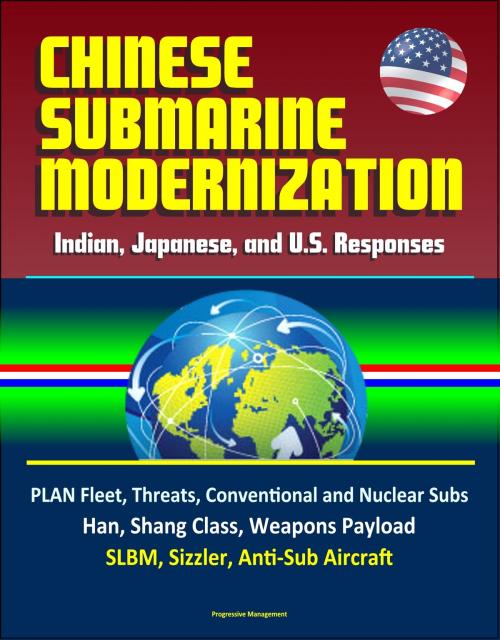Chinese Submarine Modernization: Indian, Japanese, and U.S. Responses - PLAN Fleet, Threats, Conventional and Nuclear Subs, Jin, Han, Shang Class, Weapons Payload, SLBM, Sizzler, Anti-Sub Aircraft
Nonfiction, History, Asian, China, Military, Naval| Author: | Progressive Management | ISBN: | 9781370987771 |
| Publisher: | Progressive Management | Publication: | October 24, 2016 |
| Imprint: | Smashwords Edition | Language: | English |
| Author: | Progressive Management |
| ISBN: | 9781370987771 |
| Publisher: | Progressive Management |
| Publication: | October 24, 2016 |
| Imprint: | Smashwords Edition |
| Language: | English |
This excellent report has been professionally converted for accurate flowing-text e-book format reproduction. Nations in the Asia-Pacific region are modernizing their naval fleets, and many are choosing to use submarines as the centerpiece of these plans. China, one of the most influential nations in the region, has upgraded its submarine force, and it is important to analyze the impact this modernization effort will have on the stability of the region. India, Japan, and the United States are closely watching the People's Liberation Army Navy's (PLAN's) submarine force to understand better China's intentions writ large, and the implications they have for security. All three nations have reacted in response to the PLAN's modernization goal. This study concludes that the most effective policy going forward would be a balanced combination of both hard and soft hedging (including dialogue with the PLAN) to defend allied security interests but also to provide avenues for promoting future regional stability.
CHAPTER I - INTRODUCTION * A. MAJOR RESEARCH QUESTION * B. SIGNIFICANCE OF THE RESEARCH QUESTION * C. LITERATURE REVIEW * 1. Defining a Modernized Submarine Fleet * 2. The PLAN Submarine Modernization * 3. Literature from India * 4. Literature from Japan * 5. Literature from the United States * D. RELEVANT SECURITY CONCEPTS * 1. Security Dilemma * 2. Dangers of Submarines * 3. Ways to Respond to the Submarine Threat * E. POTENTIAL EXPLANATIONS, HYPOTHESIS, AND ROADMAP * CHAPTER II - CHINESE SUBMARINE MODERNIZATION * A. BACKGROUND * B. TYPES OF SUBMARINES * 1. Conventional Submarines * a. SS Type 035, Ming-class * b. SSG Type 039/039G, Song-class * c. SSG Kilo-class (Project 877EKM/636) * d. SSG Type 039A/041 Yuan-Class * 2. Nuclear Submarines * a. SSBN Type 094, Jin-class * b. SSN Type 091, Han-class * c. SSN Type 093, Shang-class * 3. Air Independent Propulsion Submarines * 4. PLAN Submarine Growth * C. OPERATIONS * D. SUBMARINE WEAPONS PAYLOAD * 1. SLBM JL-2 Missiles * 2. SS-N-27 Sizzler * 3. Yu-5 Torpedo * E. CONCLUSIONS * CHAPTER III - INDIA'S VIEWS ON CHINESE SUBMARINE MODERNIZATION * A. SINO-INDIAN DISPUTES * 1. Border Dispute * 2. China's Relationship with Pakistan * B. INDIA'S RESPONSE TO CHINESE SUBMARINES * 1. Hard Hedging * a. Modernization of Anti-Submarine Ships * b. Anti-submarine Aircraft * c. Submarines * d. Exercises * 2. Soft Hedging * C. INDIA'S MARITIME INTERESTS * 1. Economic Security * a. Navy's Security Role * b. Strategic Location * 2. Natural Resources * D. CONCLUSION * CHAPTER IV - JAPANESE VIEWS ON CHINESE SUBMARINE MODERNIZATION * A. SINO-JAPANESE RIVALRY * 1. Misaligned Memories * 2. Disputed Islands * B. JAPAN'S RESPONSE TO CHINESE SUBMARINES * 1. Hard Hedging * 2. Soft Hedging * C. NAVAL STRATEGY IN CONFLICT * 1. Economic Development * 2. Environment of Stability, Transparency and Predictability * D. CONCLUSION * CHAPTER V - UNITED STATES' VIEWS ON CHINESE SUBMARINE MODERNIZATION * A. DIVERGENT SECURITY CONCERNS * 1. U.S. Alliances * 2. Chinese Embassy in Yugoslavia * 3. EP-3 Aircraft Incident * 4. USNS Impeccable Incident * B. U.S. RESPONSE TO CHINESE SUBMARINE MODERNIZATION * 1. Threat Perceptions Seen from the United States * 2. Hard Hedging * C. CONCLUSION * CHAPTER VI - RECOMMENDATIONS AND CONCLUSION * A. U.S. HARD HEDGING * B. U.S. AND JAPAN HARD HEDGING * C. INDIA HARD HEDGING * D. SOFT HEDGING * E. CONCLUSION
This excellent report has been professionally converted for accurate flowing-text e-book format reproduction. Nations in the Asia-Pacific region are modernizing their naval fleets, and many are choosing to use submarines as the centerpiece of these plans. China, one of the most influential nations in the region, has upgraded its submarine force, and it is important to analyze the impact this modernization effort will have on the stability of the region. India, Japan, and the United States are closely watching the People's Liberation Army Navy's (PLAN's) submarine force to understand better China's intentions writ large, and the implications they have for security. All three nations have reacted in response to the PLAN's modernization goal. This study concludes that the most effective policy going forward would be a balanced combination of both hard and soft hedging (including dialogue with the PLAN) to defend allied security interests but also to provide avenues for promoting future regional stability.
CHAPTER I - INTRODUCTION * A. MAJOR RESEARCH QUESTION * B. SIGNIFICANCE OF THE RESEARCH QUESTION * C. LITERATURE REVIEW * 1. Defining a Modernized Submarine Fleet * 2. The PLAN Submarine Modernization * 3. Literature from India * 4. Literature from Japan * 5. Literature from the United States * D. RELEVANT SECURITY CONCEPTS * 1. Security Dilemma * 2. Dangers of Submarines * 3. Ways to Respond to the Submarine Threat * E. POTENTIAL EXPLANATIONS, HYPOTHESIS, AND ROADMAP * CHAPTER II - CHINESE SUBMARINE MODERNIZATION * A. BACKGROUND * B. TYPES OF SUBMARINES * 1. Conventional Submarines * a. SS Type 035, Ming-class * b. SSG Type 039/039G, Song-class * c. SSG Kilo-class (Project 877EKM/636) * d. SSG Type 039A/041 Yuan-Class * 2. Nuclear Submarines * a. SSBN Type 094, Jin-class * b. SSN Type 091, Han-class * c. SSN Type 093, Shang-class * 3. Air Independent Propulsion Submarines * 4. PLAN Submarine Growth * C. OPERATIONS * D. SUBMARINE WEAPONS PAYLOAD * 1. SLBM JL-2 Missiles * 2. SS-N-27 Sizzler * 3. Yu-5 Torpedo * E. CONCLUSIONS * CHAPTER III - INDIA'S VIEWS ON CHINESE SUBMARINE MODERNIZATION * A. SINO-INDIAN DISPUTES * 1. Border Dispute * 2. China's Relationship with Pakistan * B. INDIA'S RESPONSE TO CHINESE SUBMARINES * 1. Hard Hedging * a. Modernization of Anti-Submarine Ships * b. Anti-submarine Aircraft * c. Submarines * d. Exercises * 2. Soft Hedging * C. INDIA'S MARITIME INTERESTS * 1. Economic Security * a. Navy's Security Role * b. Strategic Location * 2. Natural Resources * D. CONCLUSION * CHAPTER IV - JAPANESE VIEWS ON CHINESE SUBMARINE MODERNIZATION * A. SINO-JAPANESE RIVALRY * 1. Misaligned Memories * 2. Disputed Islands * B. JAPAN'S RESPONSE TO CHINESE SUBMARINES * 1. Hard Hedging * 2. Soft Hedging * C. NAVAL STRATEGY IN CONFLICT * 1. Economic Development * 2. Environment of Stability, Transparency and Predictability * D. CONCLUSION * CHAPTER V - UNITED STATES' VIEWS ON CHINESE SUBMARINE MODERNIZATION * A. DIVERGENT SECURITY CONCERNS * 1. U.S. Alliances * 2. Chinese Embassy in Yugoslavia * 3. EP-3 Aircraft Incident * 4. USNS Impeccable Incident * B. U.S. RESPONSE TO CHINESE SUBMARINE MODERNIZATION * 1. Threat Perceptions Seen from the United States * 2. Hard Hedging * C. CONCLUSION * CHAPTER VI - RECOMMENDATIONS AND CONCLUSION * A. U.S. HARD HEDGING * B. U.S. AND JAPAN HARD HEDGING * C. INDIA HARD HEDGING * D. SOFT HEDGING * E. CONCLUSION















